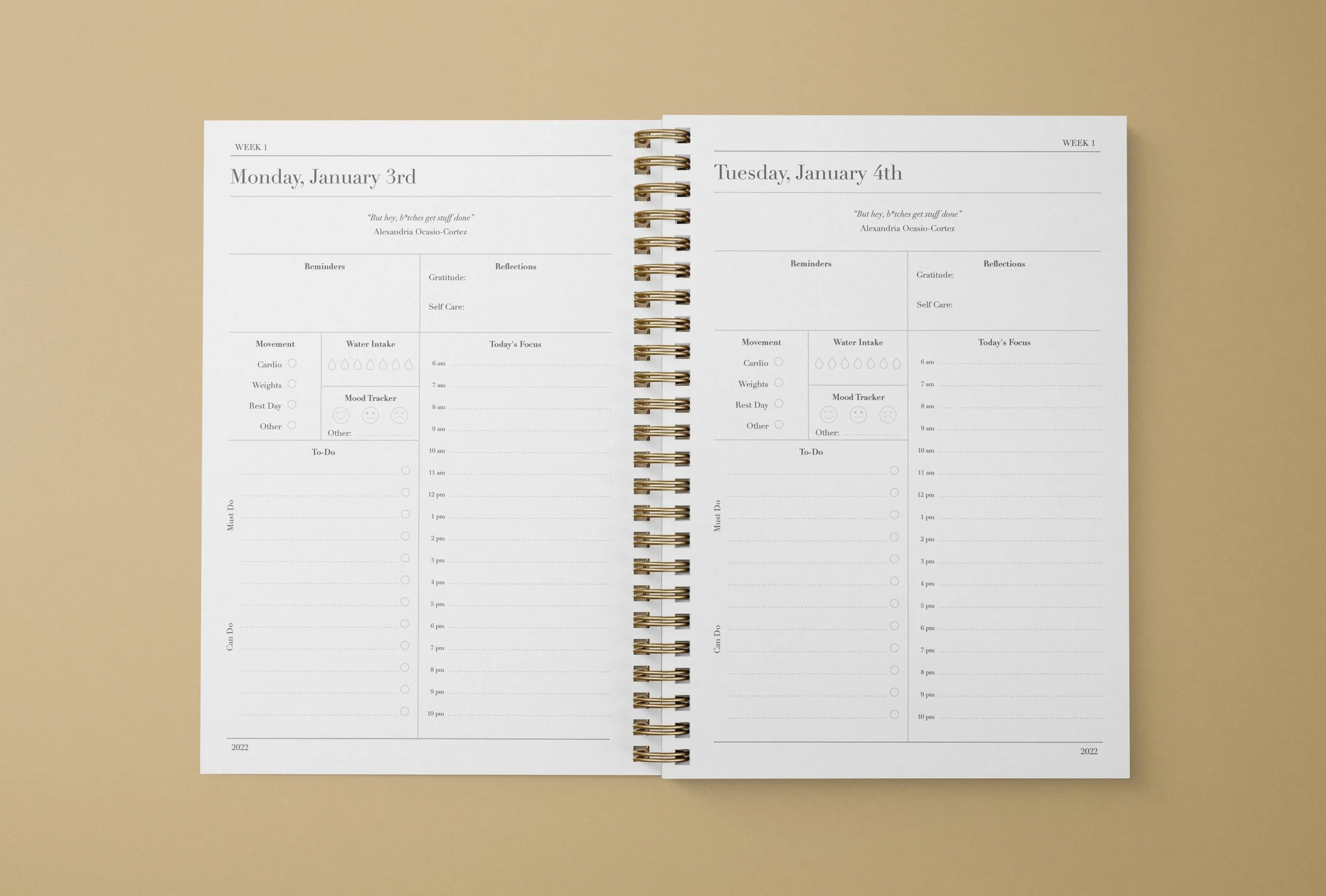Case Study: Intersecting BIPOC mental health and planners
Problem
Among the various types of planners in the U.S. market, none were specifically
created for BIPOC mental health and wellness in 2020.
Project
Design and produce a stationery product that incorporates mental health,
wellness, and organization to help BIPOC communities balance their day-to-day lives.
Target Audience
Users ranging from 18-35; Students
There isn’t an “all-in-one” planner…
How could I design a product that excludes a large portion of my target audience?
The Solution: Designing two planners
How did I get here??
Main Finding: Design Preference
Users who have a demanding schedule prefer a planner with one page per day.
Users who have a more flexible schedule prefer a planner with two pages for a whole week.
UX RESEARCH METHODS & OTHER FINDINGS
-
I conducted a 13-question survey targeting James Madison University alumni and people of color in CA, NY, and DC to gather insights on aesthetic, feature, and planner preferences. The survey received 137 responses, which were synthesized for analysis.
To deepen my understanding, I held 12 interviews with BIPOC participants from the survey. Each interview lasted an average of 30 minutes and included 5 open-ended questions, providing valuable qualitative insights.
To identify opportunities for differentiation, I performed competitor research on brands like Passion Planner, Papier, and Intellect Change. These brands included some mental health components, but none focused specifically on creating resources for people of color. I analyzed negative reviews, highlighted features users enjoyed, and assessed their marketing strategies to inform my design approach.
-
Physical and Digital Integration: Users rely on both physical planners and digital tools, with a strong openness to digital planners, particularly for reminders and long-term goal tracking.
Versatile Applications: Planners are essential for managing school, work, and personal life, with Monday being the preferred start day for weekly layouts.
Desired Features: To-do lists (especially separating personal and work tasks), blank spaces, and inspirational quotes are highly valued in physical planners.
Design Preferences: Male users favor minimal layouts with ample blank space, while those with busy schedules prefer time-blocking and space for listing tasks.
Self-Care Emphasis: A reflection section dedicated to self-care is a sought-after feature among users.
Designing the solution
I created persona profiles for each planner, Jameelah for the daily and Ashley for the weekly to help me better understand the needs of each user when designing each product.
DAILY PLANNER
Made for the friend who books all the reservations, enjoys color coordinating your closet for fun, and watches organizing videos on TikTok
WEEKLY PLANNER
Made for the “just Venmo charge me” friend, takes incredible photos of anyone and anything, and watches crafting videos on TikTok
-
Each planner had three prototypes developed, edited, and tested to see what users liked and did not like about the layout and functionality. This process was carried out by requesting the participants to use a PDF prototype of their assigned planner for three days. These individuals were also participants of the initial Google survey.
I gathered feedback by reviewing each filled out PDF and asked each participant the following questions over the phone:
1) Explain your annotation process.
2) List your favorite parts about this planner.
3) How can we improve the functionality and design of this product?
-
COVID-19 & SUPPLY CHAIN ISSUES
I tried my best to find a POC-owned business based in the Bay Area but alas… The pandemic. Many vendors we wanted to work with closed their businesses due to COVID-19. On top of having issues finding a reliable vendor, our order came in two months later than scheduled due to the supply chain delays.
GETTING GHOSTED
My team and I spent two months emailing vendors and finally landed on one within our budget and list of requirements. We spent another month coordinating the order and eventually got ghosted. ): We turned to international vendors and eventually found a few options in time to make our launch deadline!
SAMPLE CAT FISH
We were ready to iterate our changes and began ordering samples of our products from different vendors.
Vendor A’s sample was a catfish. The quality was not up to our standards, the color was off, and the inside pages were poorly aligned.
Vendor C’s product was B-. It checked off all the boxes except for the spine of the planner. The spiral spine was made out of a cheap metal, that bended easily. This was especially a problem for the daily planner since this product had hundreds of pages that needed to be thoroughly supported.
Vendor B was thankfully a hit. They supplied us with high-quality products and exceptional service that we still use up to this day.
What's Next?
What's Next?
Last October was the fourth annual release of our planners. The Essence Planner team and I are currently working on perfecting the newest summer 2025 collection. I’m beyond grateful for our supportive community and am excited to continue developing mental health resources for people of color. For more information about our upcoming launches check out the website link below!
















